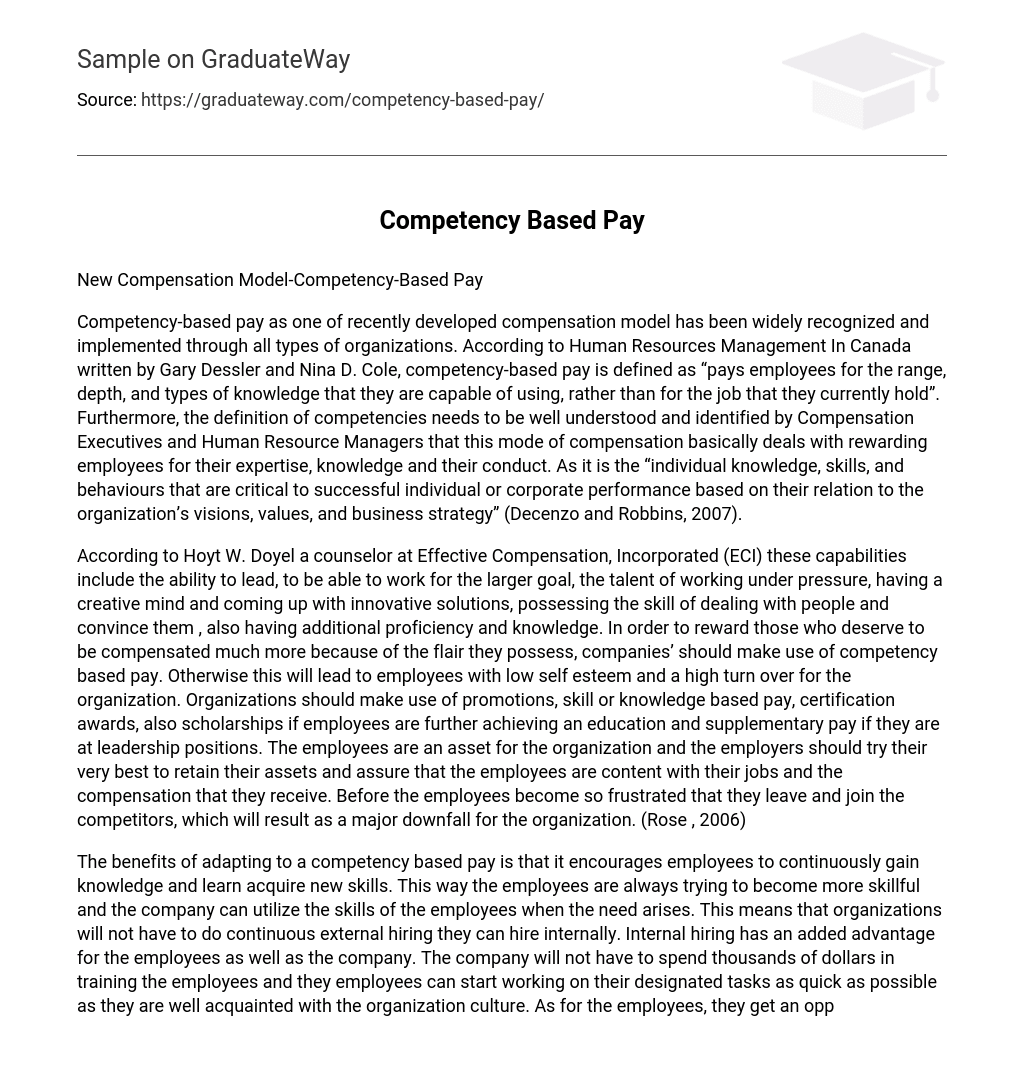New Compensation Model: Competency-Based Pay
Competency-based pay is a recently developed compensation model that has been widely recognized and implemented by all types of organizations. According to Gary Dessler and Nina D. Cole’s book, Human Resources Management In Canada, competency-based pay pays employees for the range, depth, and types of knowledge they are capable of using rather than for the job they currently hold.
Compensation executives and human resource managers need to well understand and identify the definition of competencies as this mode of compensation deals with rewarding employees for their expertise, knowledge, and conduct. It is the individual knowledge, skills, and behaviors critical to successful individual or corporate performance based on their relation to the organization’s visions, values, and business strategy (Decenzo & Robbins 2007).
According to Hoyt W. Doyel, a counselor at Effective Compensation, Incorporated (ECI), these capabilities include leadership, working towards larger goals, the ability to work under pressure, creativity and innovation, people skills and persuasion abilities, as well as additional proficiency and knowledge. To properly compensate those who possess such talents, companies should implement competency-based pay. Failure to do so may lead to low employee self-esteem and high turnover rates within the organization.
Organizations should offer promotions, skill or knowledge-based pay increases, certification awards and scholarships for further education to reward employees who excel in their roles. Additionally, leaders within the company should receive supplementary pay. Employees are valuable assets for any organization; employers must strive to retain them by ensuring job satisfaction through fair compensation.
If employees become frustrated with their jobs or compensation packages and leave for competitors’ organizations instead of staying with their current employer will result in a significant downfall for that organization (Rose , 2006).
The benefits of adapting to a competency-based pay system are numerous. Firstly, it encourages employees to continuously gain knowledge and acquire new skills. This means that employees are always striving to become more skillful, and the company can utilize their skills when the need arises. As a result, organizations will not have to engage in continuous external hiring; instead, they can hire internally.
Internal hiring has advantages for both the employees and the company. The company saves thousands of dollars in training costs since internal hires are already familiar with the organization’s culture and can start working on their designated tasks quickly. For employees, internal hiring provides opportunities to work in diverse positions within the company and increases chances for career advancement.
Moreover, with their diverse knowledge and experience, these employees can provide brilliant solutions to the company’s problems through their bright ideas and leadership skills. They can easily adapt to changes at work courageously cope up with any alterations that arise at work.
Furthermore, as individuals acquire more skills through this system, there will be less need for hiring more people since a single employee will be able to perform a diverse set of tasks. This means horizontal growth for both employees and companies while still embracing flatter organizational structures that provide development opportunities for members.
In conclusion, competency-based pay systems offer numerous benefits such as job switching and job enlargement as part of motivational techniques applied at work places (Zingheim & Schuster 2003).
Along with its advantages, competency-based compensation also has associated disadvantages. For example, employees may be paid for skills they possess but are not utilizing in their work. This means the company is incurring added expenditure by compensating employees for abilities that are not being utilized at the workplace. Furthermore, competent employees regularly learn new skills, and if the company were to pay them for all newly acquired proficiencies, it would end up being in a state of loss.
Additionally, some competencies are difficult to measure, such as creativity, leadership skills, and negotiation skills. If managers do not fairly include these competencies in staff compensation packages, biases may cause frustration among employees and lead to decreased productivity (Zingheim & Schuster, 2003).
Introducing this new concept will also incur significant training and support costs initially. Additionally,the model is quite complicated and time-consuming to implement on a daily basis.
The adoption of this new compensation model indicates that the traditional pay program is no longer efficient in motivating employees to achieve their best working performance, which contributes to the overall success of organizations. The underlying theme of adopting this new compensation model is to recognize employees’ individual value and use it as a management tool to motivate them to achieve desired working performance (Rose, 2006).
Additionally, competency-based pay has been confirmed to be more successful when utilized for professional people or those who are in middle or top managerial positions. Dow Chemical and Motorola are just two well-known companies with a strong research background that have moved towards a competency-based pay system. Companies should ensure that they utilize competency-based pay systems for jobs where skills are highly valued. If companies reward employees with large sums of money for capabilities that are not useful, the organization will bear additional expenses which will not be fruitful for the overall purpose of the organization (Zingheim & Schuster, 2003).
Reference
Gross, Steven E. (1995). Compensation for Teams: How to Design and Implement Team-Based Reward Programs.
Decenzo A. and Robbins S.P (2001). Human Resource Management, Seventh Edition.
Rikleen, Lauren Stiller (2007) argues that it is time to reappraise performance appraisals in her article titled Time to Reappraise Performance Appraisals” published in Management Corner.
Rose, T. Allen (2006) argues that separating performance appraisals from salary reviews can enhance staff progress.
Wilson, Thomas B. (1994). Innovative Reward Systems for the Changing Workplace.
Zingheim, Patricia K. and Schuster, Jay R. (2003) examined whether competencies and rewards are substance or just style in their article published in Compensation & Benefits Review.
Visit http://www.ipma-hr.org/content.cfm?pageid=52 for more information.





